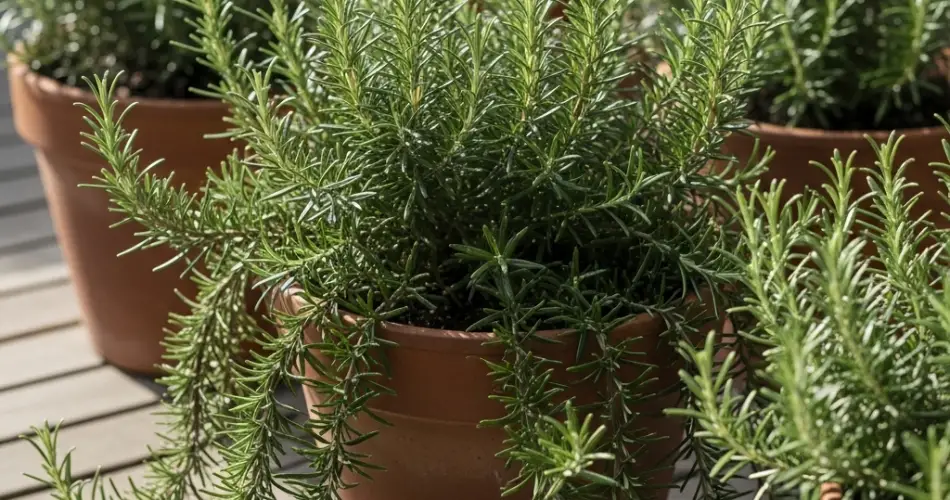Rosemary is a fragrant, woody herb beloved for its needle-like leaves and bold, piney aroma. Used extensively in Mediterranean cuisine, it adds depth to roasted meats, potatoes, breads, and sauces. In addition to its culinary uses, rosemary’s ornamental beauty and resilience make it a fantastic candidate for container gardening.
Growing rosemary in containers offers flexibility, especially for gardeners in colder climates where this evergreen shrub might not survive the winter outdoors. With the right container, care routine, and growing conditions, you can keep your rosemary healthy and productive throughout the entire year.
Why Grow Rosemary in Containers?
Rosemary thrives in containers because:
-
You can move it indoors during winter
-
It allows better control over soil drainage
-
It’s ideal for patios, balconies, windowsills, and small gardens
-
Container growing prevents excessive spreading and woodiness
-
Harvesting is easier and more accessible
Whether you live in a temperate zone or a cold region, growing rosemary in a pot ensures a longer and healthier life for your plant.
Choosing the Right Container
Selecting the appropriate pot is crucial for rosemary’s health:
-
Size: Choose a pot that’s at least 12 inches wide and 10–12 inches deep. Rosemary has a deep root system and needs room to grow.
-
Material: Terracotta pots are ideal because they allow excess moisture to evaporate through the walls, preventing root rot. However, plastic and ceramic pots also work if they have good drainage.
-
Drainage: Ensure the container has multiple drainage holes at the bottom. Rosemary dislikes “wet feet” and thrives in well-drained conditions.
Place a saucer or tray underneath if the pot is indoors, but avoid letting water sit in it.
Ideal Soil for Rosemary
Rosemary prefers well-draining, sandy or loamy soil. For container planting:
-
Use a high-quality potting mix
-
Mix in coarse sand or perlite (about 20–30%) to improve drainage
-
Avoid heavy or clay-based soils
-
Keep the pH between 6.0 and 7.0 (neutral to slightly acidic)
Overly rich or moisture-retentive soil can lead to soggy roots and diseases.
Light and Temperature Requirements
Rosemary loves sunshine. Place the container where it will receive:
-
At least 6–8 hours of direct sunlight per day
-
Preferably full sun exposure (south or west-facing spots)
Indoors, keep rosemary near a bright window. If natural light is limited, supplement with a grow light to maintain growth and prevent the plant from becoming leggy.
Temperature tips:
-
Rosemary grows best between 60–80°F (15–27°C)
-
It can tolerate cool weather but should be brought indoors when temperatures dip below 30°F (-1°C)
Watering Rosemary in Containers
One of the most common mistakes with rosemary is overwatering. This Mediterranean herb is drought-tolerant and prefers drier conditions once established.
Watering tips:
-
Let the top 1–2 inches of soil dry out before watering
-
Water thoroughly, allowing excess to drain from the bottom
-
Reduce watering in the winter when growth slows down
-
Indoors, avoid high humidity and ensure good air circulation
Yellowing leaves or root rot are signs of overwatering.
Feeding and Fertilizing
Rosemary doesn’t need heavy feeding. In fact, too much fertilizer can reduce its flavor intensity.
Feed it:
-
Once every 4–6 weeks during the growing season
-
Use a diluted, balanced liquid fertilizer (10-10-10) or organic compost tea
-
Avoid fertilizing in winter when the plant is dormant or growing slowly
Pruning and Harvesting
Pruning encourages bushier growth and keeps rosemary manageable in containers.
How to prune and harvest:
-
Start snipping once the plant reaches about 6–8 inches in height
-
Use clean scissors to trim just above a leaf node
-
Regularly cut back long stems to maintain shape and encourage new growth
-
Avoid removing more than one-third of the plant at a time
-
Pinch off any flower buds if you want to prolong leaf production
You can use rosemary fresh or hang cut stems upside down to dry and store in airtight jars.
Pest and Disease Prevention
Rosemary is fairly pest-resistant, but potted plants can sometimes suffer from:
-
Spider mites
-
Whiteflies
-
Aphids
-
Powdery mildew (especially in humid indoor conditions)
To prevent problems:
-
Keep leaves dry
-
Provide good airflow around the plant
-
Use neem oil or insecticidal soap if needed
-
Inspect leaves regularly for signs of pests or mildew
Overwintering Rosemary Indoors
If you live in a region with cold winters, bring rosemary indoors before the first frost. Here’s how to help it transition:
-
Gradually reduce watering before moving indoors
-
Place it in a bright room with plenty of sunlight or a grow light
-
Avoid high humidity—keep the plant in a cool, dry spot
-
Reduce feeding and watering frequency
Even indoors, rosemary may slow down in winter. Don’t worry—new growth will resume in spring.
Repotting and Long-Term Maintenance
Rosemary will eventually outgrow its container. Repot every 1–2 years to refresh the soil and give the roots more room.
Steps to repot:
-
Choose a slightly larger pot with drainage holes
-
Gently loosen the root ball and remove old soil
-
Replant using fresh potting mix with added sand or perlite
-
Water lightly and place in bright light
With regular care, a container-grown rosemary plant can live for many years.
Conclusion
Rosemary is a beautiful, hardy herb that adapts well to life in containers when given the right conditions. Full sun, well-draining soil, minimal watering, and occasional pruning are the keys to success. Whether you’re harvesting sprigs for cooking or enjoying its decorative foliage, rosemary rewards your efforts with year-round greenery and bold, aromatic flavor—perfect for every home garden, indoors or out.



